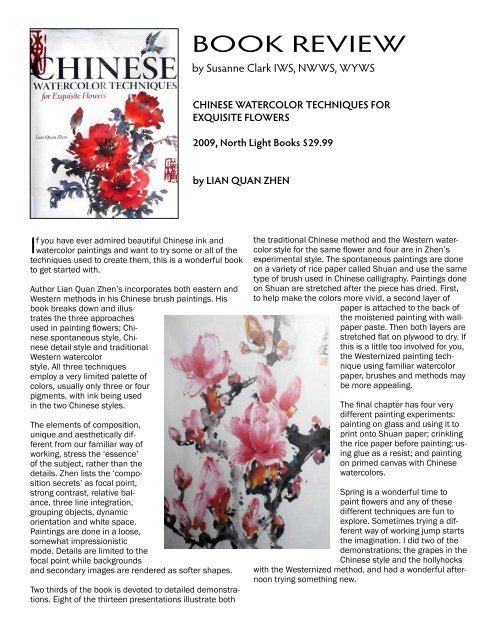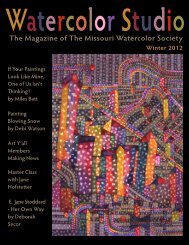Watercolor Studio - Missouri Watercolor Society
Watercolor Studio - Missouri Watercolor Society
Watercolor Studio - Missouri Watercolor Society
You also want an ePaper? Increase the reach of your titles
YUMPU automatically turns print PDFs into web optimized ePapers that Google loves.
If you have ever admired beautiful Chinese ink and<br />
watercolor paintings and want to try some or all of the<br />
techniques used to create them, this is a wonderful book<br />
to get started with.<br />
Author Lian Quan Zhen’s incorporates both eastern and<br />
Western methods in his Chinese brush paintings. His<br />
book breaks down and illustrates<br />
the three approaches<br />
used in painting flowers; Chinese<br />
spontaneous style, Chinese<br />
detail style and traditional<br />
Western watercolor<br />
style. All three techniques<br />
employ a very limited palette of<br />
colors, usually only three or four<br />
pigments, with ink being used<br />
in the two Chinese styles.<br />
The elements of composition,<br />
unique and aesthetically different<br />
from our familiar way of<br />
working, stress the ‘essence’<br />
of the subject, rather than the<br />
details. Zhen lists the ‘composition<br />
secrets’ as focal point,<br />
strong contrast, relative balance,<br />
three line integration,<br />
grouping objects, dynamic<br />
orientation and white space.<br />
Paintings are done in a loose,<br />
somewhat impressionistic<br />
mode. Details are limited to the<br />
focal point while backgrounds<br />
and secondary images are rendered as softer shapes.<br />
Two thirds of the book is devoted to detailed demonstrations.<br />
Eight of the thirteen presentations illustrate both<br />
BOOK REVIEW<br />
by Susanne Clark IWS, NWWS, WYWS<br />
CHINESE WATERCOLOR TECHNIQUES FOR<br />
EXQUISITE FLOWERS<br />
2009, North Light Books $29.99<br />
by LIAN QUAN ZHEN<br />
the traditional Chinese method and the Western watercolor<br />
style for the same flower and four are in Zhen’s<br />
experimental style. The spontaneous paintings are done<br />
on a variety of rice paper called Shuan and use the same<br />
type of brush used in Chinese calligraphy. Paintings done<br />
on Shuan are stretched after the piece has dried. First,<br />
to help make the colors more vivid, a second layer of<br />
paper is attached to the back of<br />
the moistened painting with wallpaper<br />
paste. Then both layers are<br />
stretched flat on plywood to dry. If<br />
this is a little too involved for you,<br />
the Westernized painting technique<br />
using familiar watercolor<br />
paper, brushes and methods may<br />
be more appealing.<br />
The final chapter has four very<br />
different painting experiments:<br />
painting on glass and using it to<br />
print onto Shuan paper; crinkling<br />
the rice paper before painting; using<br />
glue as a resist; and painting<br />
on primed canvas with Chinese<br />
watercolors.<br />
Spring is a wonderful time to<br />
paint flowers and any of these<br />
different techniques are fun to<br />
explore. Sometimes trying a different<br />
way of working jump starts<br />
the imagination. I did two of the<br />
demonstrations; the grapes in the<br />
Chinese style and the hollyhocks<br />
with the Westernized method, and had a wonderful afternoon<br />
trying something new.



